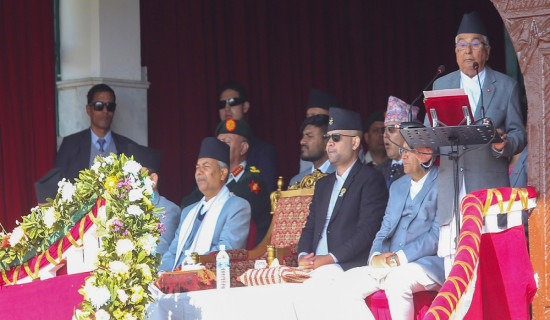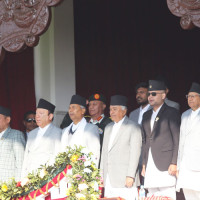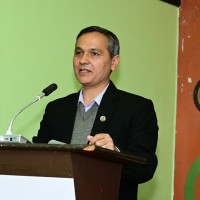- Monday, 15 December 2025
Arunachal: A Sweet Connection With Nepalis
“Number one, we look like Nepalis. We are with Nepalis at home and in the jungles, and there are many Nepalis in Arunachal Pradesh,” says Tokbom Borang, owner of the NEFA Orange farm in Dambuk, Arunachal Pradesh. Borang stated that the Arunachalis trust Nepalis because they don’t lie. “Maybe out of 100, one or two drink or do otherwise, but 80 per cent of the Nepalis are very trustworthy. Indian citizens here and are very much respected, so I like Nepalis very much,” he continued. Then, to my surprise, he started singing an old but popular Nepali song, ‘Kanchi re Kanchi’. Borang told me that he enjoyed watching movies featuring Manisha Koirala and conversed a bit with me in workable Nepali. I met Borang at his orange orchid during my trip when I was invited to participate in the Orange Festival of Music and Adventure (OFAM) at Dambuk in the Dibang Valley of Arunachal Pradesh during December 14–18, 2023. There, I was pleasantly surprised to meet several Arunachalis who like Nepal and Nepalis a lot.
During the inauguration of the festival, I had the opportunity to interview Pema Khandu, the Chief Minister of Arunachal Pradesh (AP). “There is a Buddha connection between Nepal and Arunachal Pradesh, so we can develop tourism through the Buddhist circuit," said Pema. He emphasised the fact that PM Narendra Modi’s policies have helped a lot in the development of the eight north-eastern states of India.
The geographical location of Arunachal Pradesh and its cultural environment are very similar to those of Thailand, Myanmar, other north-eastern states of India, and even eastern Nepal. Therefore, India's Arunachal Pradesh has a lot of similarities with South Asia and Southeast Asia. Arunachal Pradesh is landlocked and has snow-capped mountains, hills, and rivers like the Brahmaputra, which captivate the minds of nature lovers and spiritually inclined people. It is the state where the sun rays touch the Indian soil earliest every morning and is known as the Land of the Dawn-lit Mountains. It lies on the north-eastern tip of India, bordering China, Bhutan, and Myanmar. It is, in fact, one of the remotest states in India.
The orange festival, which was started in 2015 as a tourism development strategy, has been taking place every year since then. This has positively impacted the promotion of tourism in the state. CM Khandu says that many programmes have been organised in Arunachal through the Prime Minister's Tourism Development and Dindayal Upadhyay Schemes. He said that Dambuk produced the sweetest oranges possible, and thus their focus was to export these oranges outside India. The festival helps in promoting the export of oranges and also in welcoming guests from other parts of India and other countries to boost the tourism of the state.
There are now more than 50 orange plantations in Arunachal Pradesh. Orange production is also good in Dambuk, Kameng, Lohit, and Suyang. Such festivals have helped to make the local oranges famous even abroad. Chief Minister Khandu said that the current Prime Minister's Northeast policy has brought about a big change in the roads and physical infrastructure of Arunachal. He said that in addition to receiving a lot of support from the centre for the development of the province, the local people have also started investing.
During my visit to the NEFA Orange Orchid, its owner, Tokbom Borang, informed me that he had earned one crore rupees by spending 14–15 lakhs in his orchard, which was started in 2018. “In nine years, I have been earning and recovering. “I hire fewer people, mainly women’s groups and youth. They benefit from me and I from them; I have not taken any loans, but the government helped me set up my orange farm,” says Borang. He mentioned that the Orange Festival was essential, and they had to acknowledge the contribution of Abu Tayeng, who came up with the idea of this festival. Before this festival, the people’s economies were different. Now many youths have started growing oranges in big or small amounts, and they are earning. Borang mentioned that he exported oranges twice last year.
The buyer came to his garden with 200–300 labourers and took the oranges on 27 trucks. It took him one month to complete the task of plucking oranges from his garden. The oranges were exported to Dubai. He claims that NEFA Garden is the largest orange producer in the Northeast. “I have 4200 orange trees in my garden, and I earned 47 lakhs this year, which is a higher yield than a garden run by another farmer with 9000 trees,” he proudly mentioned. 'It is very difficult to work in such a difficult geographical area. I could have gone elsewhere to look for opportunities, but here the government has encouraged orange cultivation, and I stayed on to do exactly that', says Boranag.
Lakhpa Tsering, the President of the Motor Sports Club of Arunachal Pradesh and one of the organisers of OFAM, shared his experience of hosting a festival in the north-eastern tip of India. “When we started the Orange Festival with Abu Tayeng as the director of the festival, this place was like Kalapani, which was forever cut off physically from all other regions of India. That time there were no roads, so we thought of doing off-roading events, but since then and now, the same area that needed hours to be reached can be reached in minutes, so we have started motor road races too,” says Lakhpa. He further added that the NE was totally neglected earlier, but the BJP government is bringing airports, railway stations, and roads with accountability to the people of this region. He mentioned that the education system was also improving with more colleges like the NITs.
Lakhpa’s family is known to own one of the best wineries in India. “Our winery is a family business that was possible to get started only because of government policies, and I can happily tell you that it is doing well, and we sell it to other parts of India,” he said. His wines are produced from apples, kiwi, and honey ginger, all sourced from Arunachal. He says that Nepal, having the Himalayas, has mountain people, and the commonality with people from Arunachal is that we are all people with good hearts who need to work hard for our livelihoods.
The construction of the Dr. Bhupen Hazarika Bridge, inaugurated by Narendra Modi in 2017, drastically changed life in Arunachal Pradesh. This is known as a major bridge between Dhola and Sadias Ghats. This bridge joins Assam and Arunachal Pradesh, and the people of the two states feel that initiatives like these have helped in resolving land disputes between the two states and also provided a beam of hope for the people of the Northeastern states to build their economies and have more mobility within the region and the country. This bridge is the first permanent road connection between northern Assam and eastern Arunachal Pradesh. It is 9.15 km in length and is now the longest bridge in India. It has been designed to handle heavy-weight tanks. This bridge has also helped boost tourism in the region.
Apart from focusing on oranges, the festival also transformed the town of Dambuk into a vibrant hub of culture, adventure, and music. The festival was organised by the state and central government for the eighth consecutive year to enhance the production of oranges in the northeastern state. In order to make the function lively, bands such as Apache from the UK, Bombay Vi King, and POD also performed in Dambuk.
Abu Tyeng, the Secretary of Sports and Youth and Tourism Department of the province, is credited with starting Dambuk's orange festival and promoting tourism. The son of the first IAS officer of Arunachal Pradesh, he is also an IAS officer and is involved in the development of the province. Tyeng is another Arunachali who has a soft corner for Nepal and the Nepali community of Indian citizens.
He said that he has many Nepali friends, and they grew up together. As Nepali songs are very popular in Arunachal, he said that in the past, several Nepali bands were invited to perform at the Dambuk Orange Festival, and they were loved by the people there.
Many provinces in India have a presence of migrant Nepalis. Many people like Nepalis in Arunachal Pradesh. Nepalis here are involved in various professions. There are also Nepali speakers from Arunachal and Assam who are responsible for the arrangement of food at the festival, the management of issues like homestays, and 'event management'.
'Rafting and road motor rallies, which are popular with tourists, are becoming popular here,' says Anand Tsering, vice president of the Motor Sports Club of Arunachal Pradesh. Tsering is an Assamese Indian of Nepali origin. He is also a successful 'fast car racer' and champion. He, along with several other Nepali-origin Indians, are important pillars of the festival.
Nepal can learn from the development of tourism and the promotion of local produce in Arunanchal. Dambuk is located in the Diwang Valley of Arunachal Pradesh. This is the least-populated district in India. Nepal has excellent production of apples and oranges in places like Jumla, Gorkha, Dhankuta, and elsewhere. Recently, it has been seen that macadamia nuts and kiwi can also be grown, provided proper care is given. The government here, too, has policies encouraging the production and marketing of local produce. Gorkha's oranges and Jumla's apples can be internationalised in the style of Arunachal’s oranges. The leadership there has won the hearts and votes of the people by developing the state. In Dambuk, where there were no hotels before 2015, now homestays and resorts have emerged.
Arunachal Pradesh and other Northeast states of India bear a lot of similarities with Nepal. Many of them have 20 to 30 per cent Nepali-origin residents who are settled there and feel very proud of the fact that they are Indians, but they maintain their Nepali culture and heritage. OFAM includes adventures involving off-road driving, zip lines, gas balloon rides, river rafting, trekking, and cultural and traditional dances. These are sports, except for gas balloon rides, that are popular in Nepal too. Therefore, a collaboration between Arunachal Pradesh and Nepal could be a possibility in the future.
The Ministry of Tourism should make favourable policies for promoting tourism all over Nepal, which has huge potential in the tourism sector. Besides hydroelectric projects, the government is lacking in promoting agro-tourism, which has a high potential and rate of return for Nepal and Nepalis. This could generate huge employment opportunities for the Nepali youths who are migrating at record rates to the Middle East, Malaysia, and elsewhere at great risk to their lives. The Nepali youths who have plans to migrate abroad and work, for example, in orange or apple orchids, should be encouraged to start their own enterprises with support from the central and provincial governments.After a few days in Arunachal, one returns with a lot of spiritual, mental, and physical well-being. The pristine beauty of the Northeastern Tip of India has the potential to steal the hearts of all who visit.
(The author is a senior journalist and women's rights advocate.)
















